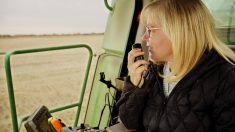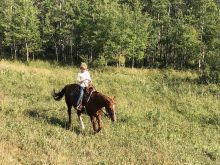The beginning of the new year found us hauling bales. Gregory and John hauled slough bales the first week of January. Then, with the help of the blade on the tractor, they were able to plow snow and get 80 flax straw bales home on Jan. 8 and 9.
On Jan. 11 Gregory drove his new JD 4020 into Western Sales in Biggar so that they could fix the PTO brake. It was a chilly 50 km drive to town. On Jan. 12 Gregory and John went over to the Landis hayfield and pushed snow to make trails and clearings so that they could gather the bales up and stack them in loads.
Read Also

In times of mandatory joy, try to find contentment
If we’re not feeling the joy at a time of year that seems to insist on over-the-top moments of happiness, we can allow ourselves to just try for fulfilled or content, farm family coach Kalynn Spain suggests.
The following day we had rain in the morning and a blizzard in the afternoon. The wind was blowing so hard that Gregory decided it was a good day to figure out how to hook up the generator for the yard and John and Barb’s house in case the power went out for any length of time. The power did not go out that day, but less than a week later it was off for several hours and thanks to the planning, Gregory was able to get the generator going right away and so keep the waterers from freezing, the feed tractor plugged in and able to start, and to get power to John and Barb’s house.
On Jan. 15 and 16 we brought home all of the hay bales from Landis. Jan 16 was also John’s 75th birthday. We got him home in time to have some supper and cake with his grandkids.
On Jan. 18 we worked on bringing the last of the ditch bales home. We had gotten most of them before the first big snow, but the last few loads were under some pretty deep snow. We used the 4450 loader tractor and a sling and pulled the bales out of the five to six feet of snow in the ditches. It was slow going but we got them all out and didn’t get the tractor stuck once. Most of them are very nice hay, so it is very good to have them home in the stackyard and able to be used.

About three years ago we purchased some movable windbreak panels and set them up in the pasture east of the yard for the cows. They worked so well that we decided to buy some more. Gregory and John picked them up on Jan. 27. A couple of days later Gregory moved snow and we set the new panels up with the old panels. The cows now have a bigger bedded area that provides good protection from the east wind.
The last week of January and the first week of February were quite cold. By the second week of February, it was even colder. There were several days of -35 C with wind chills making it feel like -48 C on a few days. Thankfully before the serious cold moved in, Gregory was able to bring his 4020 home from Biggar. It is a two-hour drive on the open tractor. I went in with him and dropped him off and then did some grocery shopping. When I caught up to Gregory, he was able to warm up a bit in the Explorer before taking the tractor the rest of the way home.
We are supposed to start calving around the end of February. We pray that it isn’t as cold by then, or at least that it isn’t as windy.
















